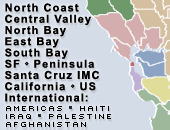From the Open-Publishing Calendar
From the Open-Publishing Newswire
Indybay Feature
Discover Gold, Reclaiming Our Past: California Pioneers of African Descent (1840-1875)
Negro Hill, Mormon Island and Negro Bar, early 1848 Gold Mining towns continue to anchor the Historic Gold Mining District where the "African Founding Father of California" helped facilitate our California Underground Railroad Network to Freedom.
Although little remembered today, Leidesdorff was a social, economic and political force in pre-gold rush San Francisco, California with a number of “firsts” credited to his name.
Discover Gold, Reclaiming Our Past: California Pioneers of African Descent (1840-1875) features Honorable William Alexander Leidesdorff, Jr. on his birthday weekend.
Leidesdorff was named the U.S. Vice Consul to Mexico in 1845, he became the nation’s first American diplomat of known African Descent. He was elected to San Francisco’s first city council and its first school board in 1847.
He built the first hotel, the first shipping warehouse, he operated the first steamboat on San Francisco Bay, and he laid out the first horse race track in California.
William Alexander Leidesdorff, Jr., was born October 23, 1810 on the island of St. Croix in the Danish West Indies, now the U.S. Virgin Islands, in 1810, William was the son of Danish sugar planter Alexander Leidesdorff and Anna Marie Sparks, a Cuban woman of African ancestry.
In 1841 Leidesdorff sailed the 106-ton schooner Julia Ann around Cape Horn to California and settled in the Mexican village of Yerba Buena on San Francisco Bay.
Over the next three years he became a successful merchant by making frequent trips between California, Mexico and Hawaii. In 1844, Mexican California Governor Micheltorena confirmed his land grant of 8 Spanish leagues, @35,521 acres, Rancho Rio De Los Americanos along the American River near Sacramento.
Ranch Rio de Los Americanos was located downstream from Coloma where James Marshall discovered gold, January 1848. Vast quantities of gold were reported on his land near where today's City of Folsom remains a transportation hub for the region.
Negro Hill, Mormon Island and Negro Bar, early 1848 Gold Mining towns continue to anchor the Historic Gold Mining District where the "African Founding Father of California" helped facilitate our California Underground Railroad Network to Freedom.
Leidesdorff died unexpectedly on May 18, 1848 he was given the buried the same day inside Mission Dolores Church, where his gravestone may still be seen today.
Discover Gold, Reclaiming Our Past: California Pioneers of African Descent (1840-1875) features Honorable William Alexander Leidesdorff, Jr. on his birthday weekend.
Leidesdorff was named the U.S. Vice Consul to Mexico in 1845, he became the nation’s first American diplomat of known African Descent. He was elected to San Francisco’s first city council and its first school board in 1847.
He built the first hotel, the first shipping warehouse, he operated the first steamboat on San Francisco Bay, and he laid out the first horse race track in California.
William Alexander Leidesdorff, Jr., was born October 23, 1810 on the island of St. Croix in the Danish West Indies, now the U.S. Virgin Islands, in 1810, William was the son of Danish sugar planter Alexander Leidesdorff and Anna Marie Sparks, a Cuban woman of African ancestry.
In 1841 Leidesdorff sailed the 106-ton schooner Julia Ann around Cape Horn to California and settled in the Mexican village of Yerba Buena on San Francisco Bay.
Over the next three years he became a successful merchant by making frequent trips between California, Mexico and Hawaii. In 1844, Mexican California Governor Micheltorena confirmed his land grant of 8 Spanish leagues, @35,521 acres, Rancho Rio De Los Americanos along the American River near Sacramento.
Ranch Rio de Los Americanos was located downstream from Coloma where James Marshall discovered gold, January 1848. Vast quantities of gold were reported on his land near where today's City of Folsom remains a transportation hub for the region.
Negro Hill, Mormon Island and Negro Bar, early 1848 Gold Mining towns continue to anchor the Historic Gold Mining District where the "African Founding Father of California" helped facilitate our California Underground Railroad Network to Freedom.
Leidesdorff died unexpectedly on May 18, 1848 he was given the buried the same day inside Mission Dolores Church, where his gravestone may still be seen today.

Add Your Comments
We are 100% volunteer and depend on your participation to sustain our efforts!
Get Involved
If you'd like to help with maintaining or developing the website, contact us.
Publish
Publish your stories and upcoming events on Indybay.
Topics
More
Search Indybay's Archives
Advanced Search
►
▼
IMC Network



